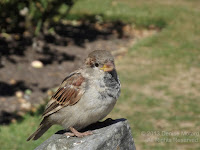HOUSE SPARROW
HOUSE SPARROW (Passer domesticus) – (See images below)
DESCRIPTION: The House Sparrow breeding male has a grey head and black mask, bill, and bib. The back of the head (nape) is rusty, as well as the back and wings, which have black streaks. The under parts are grey. The non-breeding male has less black. The female has duller colors and no black, and the bill is yellowish. On the ground, the bird is a hopper rather than a walker. This bird is around 15 cm (6 inches) long.
VOICE: https://www.xeno-canto.org/species/Passer-domesticus
NAME: The English name ‘Sparrow’ derives from Anglo-Saxon ‘Spearwa’, which means ‘flutterer’, and it has been applied to many small birds (Choate). The English word ‘house’ in the bird’s name, as well as ‘domesticus’ in the Latin name, both refer to this species’ proximity to human buildings, which they often use to build their nests. As the Latin genus name implies, it is a passerine.
HABITAT: Wide range of habitats except forest and tundra; especially adapted for dry climates by feeding on berries in absence of available water sources.
DIET: House sparrows feed on seeds, grain, and food scraps in cities. Because of their feeding habits, they can easily monopolize bird feeders as well. When raising their young house sparrows will also feed on insects.
NESTING: House sparrows that do nest in natural areas select tree holes, often displacing native species to claim the nest. They prefer cavities, so nests can be built on houses or other man-made structures. About four whitish eggs with spots are laid, which are incubated by the female. Chicks are fed by both parents.
DISTRIBUTION: The house sparrow is widespread around the world, and wherever humans settled, they brought that species with them. The house sparrow is native to Europe and parts of Asia, so its presence elsewhere in the world is due to its introduction.
DISTRIBUTION MAP: https://en.wikipedia.org/wiki/House_sparrow#/media/File:PasserDomesticusDistribution.png
ON PEI: The house sparrow is fairly common on Prince Edward Island and is a year-round resident.
CONSERVATION: Thanks to their wide distribution and large population (over 500 million), house sparrows are not considered at risk. There has been a decline in some areas however, and some possible factors include loss of habitat to degradation and use of pesticides in agricultural areas. The latter causes a decrease in insect populations, which the birds need to feed their young.
On the other hand, wherever it was introduced the house sparrow has displaced native bird species for nesting cavities.
NOTES: The house sparrow is an ‘Old World’ sparrow, NOT related to all the other ‘New World’ sparrows of North America. It is a gregarious species that feeds in flocks.
SIMILAR SPECIES: White-crowned Sparrow, Song Sparrow
REFERENCES: https://www.thespruce.com/house-sparrow-identification-385983
http://www.oiseaux-birds.com/card-house-sparrow.html
https://www.borealbirds.org/bird/house-sparrow
https://www.allaboutbirds.org/guide/House_Sparrow/id
https://www.mba-aom.ca/jsp/toc.jsp (Maritimes Breeding Bird Atlas)
https://en.wikipedia.org/wiki/House_sparrow
https://nature.mdc.mo.gov/discover-nature/field-guide/house-sparrow (Missouri Department of Conservation)
DESCRIPTION: The House Sparrow breeding male has a grey head and black mask, bill, and bib. The back of the head (nape) is rusty, as well as the back and wings, which have black streaks. The under parts are grey. The non-breeding male has less black. The female has duller colors and no black, and the bill is yellowish. On the ground, the bird is a hopper rather than a walker. This bird is around 15 cm (6 inches) long.
VOICE: https://www.xeno-canto.org/species/Passer-domesticus
NAME: The English name ‘Sparrow’ derives from Anglo-Saxon ‘Spearwa’, which means ‘flutterer’, and it has been applied to many small birds (Choate). The English word ‘house’ in the bird’s name, as well as ‘domesticus’ in the Latin name, both refer to this species’ proximity to human buildings, which they often use to build their nests. As the Latin genus name implies, it is a passerine.
HABITAT: Wide range of habitats except forest and tundra; especially adapted for dry climates by feeding on berries in absence of available water sources.
DIET: House sparrows feed on seeds, grain, and food scraps in cities. Because of their feeding habits, they can easily monopolize bird feeders as well. When raising their young house sparrows will also feed on insects.
NESTING: House sparrows that do nest in natural areas select tree holes, often displacing native species to claim the nest. They prefer cavities, so nests can be built on houses or other man-made structures. About four whitish eggs with spots are laid, which are incubated by the female. Chicks are fed by both parents.
DISTRIBUTION: The house sparrow is widespread around the world, and wherever humans settled, they brought that species with them. The house sparrow is native to Europe and parts of Asia, so its presence elsewhere in the world is due to its introduction.
DISTRIBUTION MAP: https://en.wikipedia.org/wiki/House_sparrow#/media/File:PasserDomesticusDistribution.png
ON PEI: The house sparrow is fairly common on Prince Edward Island and is a year-round resident.
CONSERVATION: Thanks to their wide distribution and large population (over 500 million), house sparrows are not considered at risk. There has been a decline in some areas however, and some possible factors include loss of habitat to degradation and use of pesticides in agricultural areas. The latter causes a decrease in insect populations, which the birds need to feed their young.
On the other hand, wherever it was introduced the house sparrow has displaced native bird species for nesting cavities.
NOTES: The house sparrow is an ‘Old World’ sparrow, NOT related to all the other ‘New World’ sparrows of North America. It is a gregarious species that feeds in flocks.
SIMILAR SPECIES: White-crowned Sparrow, Song Sparrow
REFERENCES: https://www.thespruce.com/house-sparrow-identification-385983
http://www.oiseaux-birds.com/card-house-sparrow.html
https://www.borealbirds.org/bird/house-sparrow
https://www.allaboutbirds.org/guide/House_Sparrow/id
https://www.mba-aom.ca/jsp/toc.jsp (Maritimes Breeding Bird Atlas)
https://en.wikipedia.org/wiki/House_sparrow
https://nature.mdc.mo.gov/discover-nature/field-guide/house-sparrow (Missouri Department of Conservation)
 |
| House sparrow resting on a rose, NZ |
 |
| House sparrow, Wellington, NZ |